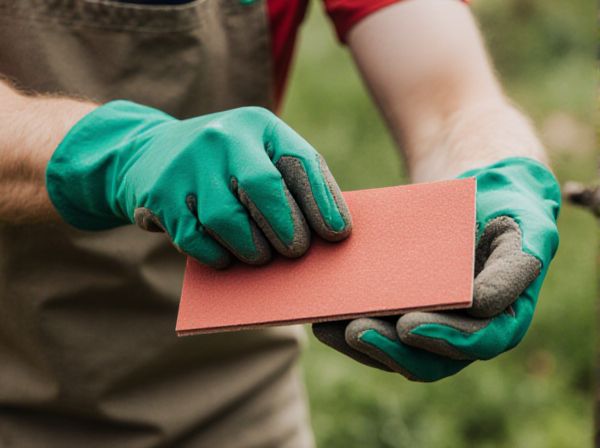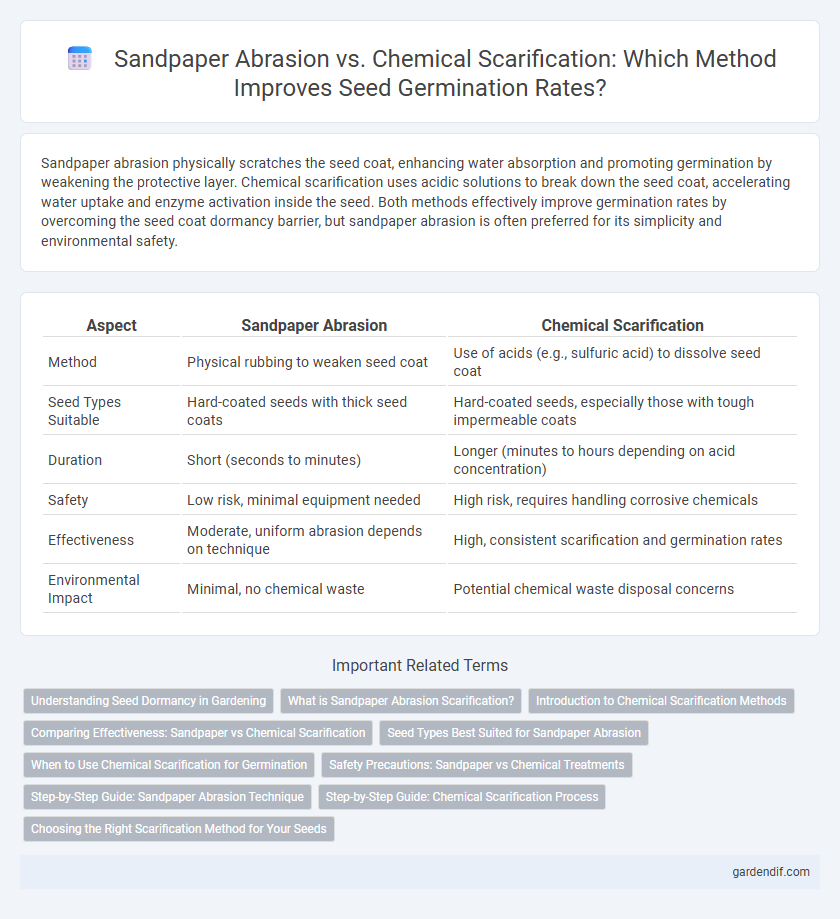
Sandpaper abrasion vs Chemical scarification Illustration
Sandpaper abrasion physically scratches the seed coat, enhancing water absorption and promoting germination by weakening the protective layer. Chemical scarification uses acidic solutions to break down the seed coat, accelerating water uptake and enzyme activation inside the seed. Both methods effectively improve germination rates by overcoming the seed coat dormancy barrier, but sandpaper abrasion is often preferred for its simplicity and environmental safety.
Table of Comparison
| Aspect | Sandpaper Abrasion | Chemical Scarification |
|---|---|---|
| Method | Physical rubbing to weaken seed coat | Use of acids (e.g., sulfuric acid) to dissolve seed coat |
| Seed Types Suitable | Hard-coated seeds with thick seed coats | Hard-coated seeds, especially those with tough impermeable coats |
| Duration | Short (seconds to minutes) | Longer (minutes to hours depending on acid concentration) |
| Safety | Low risk, minimal equipment needed | High risk, requires handling corrosive chemicals |
| Effectiveness | Moderate, uniform abrasion depends on technique | High, consistent scarification and germination rates |
| Environmental Impact | Minimal, no chemical waste | Potential chemical waste disposal concerns |
Understanding Seed Dormancy in Gardening
Sandpaper abrasion and chemical scarification are effective methods for breaking seed dormancy by weakening the seed coat to enhance water absorption and gas exchange. Sandpaper abrasion physically roughens the seed surface, increasing permeability, while chemical scarification uses acids to chemically erode the seed coat, mimicking natural processes like digestive tract passage. Understanding these techniques is crucial for gardeners aiming to improve germination rates in hard-coated seeds such as legumes and certain tree species.
What is Sandpaper Abrasion Scarification?
Sandpaper abrasion scarification is a mechanical method used to weaken the hard seed coat, facilitating water absorption and gas exchange essential for germination. This technique involves gently rubbing seeds against fine sandpaper to create microabrasions without damaging the embryo inside. It is particularly effective for seeds with tough, impermeable coats, improving germination rates by simulating natural wear processes.
Introduction to Chemical Scarification Methods
Chemical scarification methods enhance seed germination by breaking dormancy through the application of acids, such as sulfuric acid, which erodes the hard seed coat. This targeted treatment allows water and gases to penetrate the seed more effectively compared to sandpaper abrasion, resulting in faster and more uniform germination rates. The precision and efficiency of chemical scarification make it widely used for seeds with particularly tough seed coats in agricultural and horticultural practices.
Comparing Effectiveness: Sandpaper vs Chemical Scarification
Sandpaper abrasion and chemical scarification both enhance seed germination by breaking seed coat dormancy but differ in effectiveness based on seed type and condition. Sandpaper abrasion provides precise mechanical abrasion, ideal for seeds with tough, impermeable coats, promoting water uptake and gas exchange more consistently. Chemical scarification, using acids like sulfuric acid, accelerates germination by chemically softening seed coats but requires careful control to avoid seed damage or reduced viability.
Seed Types Best Suited for Sandpaper Abrasion
Sandpaper abrasion is most effective for seeds with hard, thick seed coats such as those of mesquite and acacia species, where mechanical abrasion helps to physically break the tough outer layer. This method suits seeds with impermeable seed coats that resist water penetration, requiring surface disruption for successful germination. In contrast, chemical scarification is typically reserved for seeds sensitive to mechanical damage or those with extremely hard coats needing more uniform treatment.
When to Use Chemical Scarification for Germination
Chemical scarification is most effective for seeds with hard, impermeable seed coats that prevent water absorption and delay germination. It is especially useful for leguminous seeds, such as lupines and acacias, which require precise control over exposure time to avoid damaging the embryo. Chemical agents like sulfuric acid create micro-pores quickly, making scarification preferable when rapid, uniform germination is desired over the more abrasive and less predictable sandpaper method.
Safety Precautions: Sandpaper vs Chemical Treatments
Sandpaper abrasion involves physical scraping to break seed dormancy, requiring careful handling to avoid injury or damage to seeds, while ensuring protective gloves and eye protection are worn. Chemical scarification uses acids or other chemicals to weaken seed coats, necessitating stringent safety measures such as working in a well-ventilated area, using appropriate personal protective equipment, and following disposal protocols to prevent chemical exposure. Both methods require adherence to safety guidelines to minimize risks to users and maintain seed viability.
Step-by-Step Guide: Sandpaper Abrasion Technique
Sandpaper abrasion involves gently rubbing the seed coat with fine-grit sandpaper to weaken the hard outer layer, facilitating water absorption and triggering germination. Start by selecting seeds and choosing 120- to 220-grit sandpaper, then carefully abrade the seed coat without damaging the embryo inside. Rinse the seeds to remove dust, soak them in water for 12 to 24 hours, and proceed with planting to enhance germination rates effectively.
Step-by-Step Guide: Chemical Scarification Process
Chemical scarification involves soaking seeds in a dilute acid, typically sulfuric acid, to break down the seed coat and promote germination. First, seeds are carefully placed in the acid solution for a specific time, usually ranging from 10 to 60 minutes depending on seed hardness, then quickly rinsed in water to remove all acid residues. This precise control of exposure time is crucial for maximizing seed viability while avoiding embryo damage.
Choosing the Right Scarification Method for Your Seeds
Selecting the appropriate scarification method depends on the seed type and its coat thickness; sandpaper abrasion is ideal for seeds with moderately hard coats, providing controlled mechanical wear without damaging the embryo. Chemical scarification, often using sulfuric acid, suits seeds with extremely tough coats by effectively breaking down the seed coat to enhance water absorption and germination rates. Evaluating seed sensitivity and desired germination speed guides the choice between these scarification techniques for optimal seedling emergence.
Sandpaper abrasion vs Chemical scarification Infographic

 gardendif.com
gardendif.com